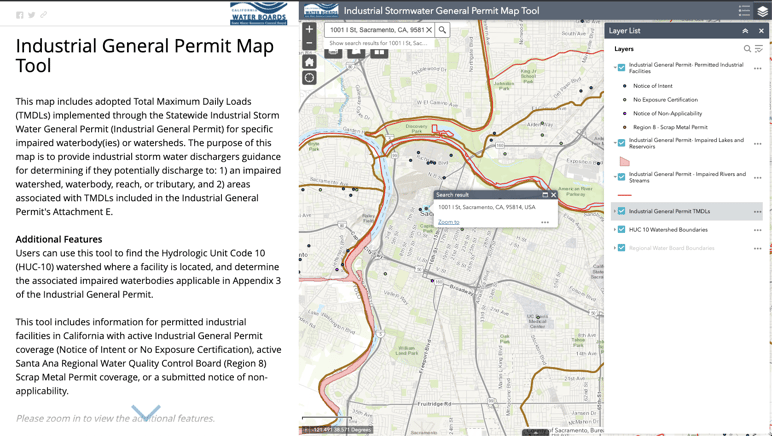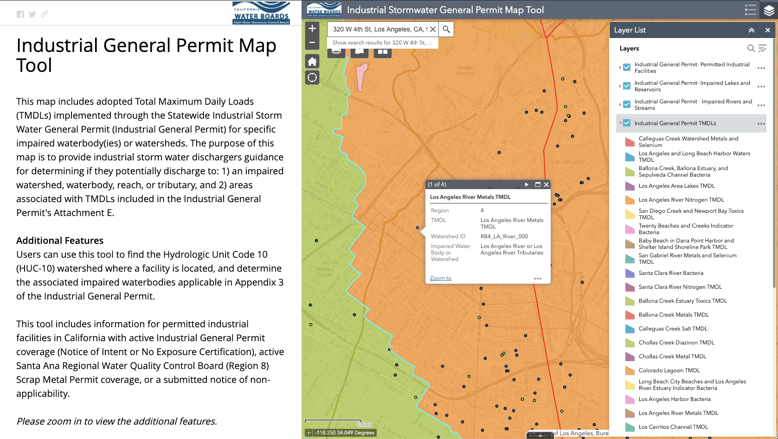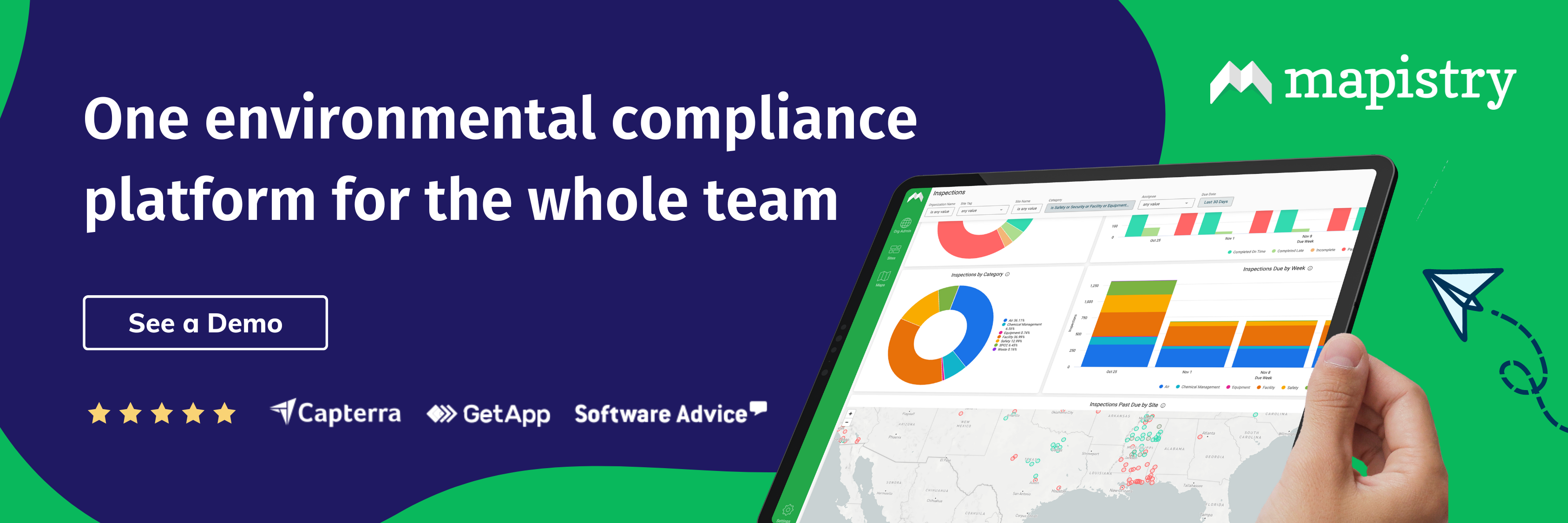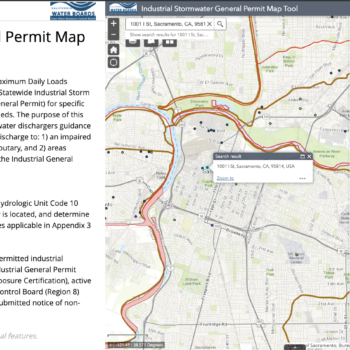On July 1, 2020, the 2018 IGP Amendments will go into effect. So, what is new in the 2018 Amendments and how do they build on the 2015 requirements? The 2018 Amendments apply to the following areas: sufficiently sensitive analytical methods, total maximum daily loads (TMDLs), alternative compliance options, and change to the SMARTS database to accommodate the Amendments (see SWRCB answers frequently asked questions about the amendments). The California State Water Resources Control Board (SWRCB) Industrial General Permit 2014-0057-DWQ (IGP) requires that each industrial facility conduct a pollutant assessment to determine which pollutants were present at the facility.
The facility pollutant monitoring requirements are based on this assessment and depending on the pollutant an instantaneous exceedance, numeric effluent limit (NEL), or an annual average, benchmark limit, are applicable. The sufficiently sensitive methods change requires that labs use approved methods that can detect concentrations of analytes to accurate levels in order to demonstrate permit compliance.
Most labs have provided their certification information in regard to EPA standards and this can be found on their websites. If you want to be certain, you can request that your labs confirm that they are compliant with ELAP and are using EPA-approved test methods. TMDLs are only applicable to specific areas and only to pollutants that were identified in your pollutant assessment. Let’s break down how to determine whether TMDLs are applicable to your facility: As discussed in a previous blog that you can review for more details, the TMDLs are developed based on individual watersheds to achieve a target water quality in that receiving water. The TMDLs only apply to your facility if you are in a watershed that has a TMDL established.
How do you know if your facility is in a TMDL watershed? The waterboard has provided an Industrial Stormwater General Permit Map Tool which allows a user to input her facility to determine if the facility is in a TMDL watershed. The SWRCB has provided a handy flow chart for determining TMDL applicability and we’ll walk through a couple of examples here.
Example 1: Facility not in a TMDL Watershed
In Figure 1 you can see that the State Water Resources Control Board office located in Sacramento is not in a watershed that has a TMDL. Region 5 has not yet developed TMDLs and so this location does not need to be concerned about the TMDLs at present. TMDLs may be developed in the future and information will be provided on that as those develop. A facility that is not in a TMDL watershed will continue with no change to its monitoring plan.

Example 2: Facility in a TMDL Watershed
In contrast to the State Board facility in Sacramento see figure 2 of the Los Angeles Regional Water Quality Control Board office. The LA RWQCB is located in the Los Angeles River watershed which has two (2) TMDLs, one for metals and one for nitrogen. This location would need to go to the next step of comparing whether the TMDL here is in their list of potential pollutants identified in their source assessment.

If you are in a TMDL watershed and the pollutant is in your source assessment, then the TMDL numeric action levels (TNALs) or NELs, as listed in Attachment E of the IGP, will need to be incorporated into your monitoring plan. An instantaneous maximum exceedance occurs when two (2) or more analytical sample results in a single reporting year exceed the applicable instantaneous maximum TNAL, NAL, or NEL. Exceedances of a TNAL (like the NALs already in the 2015 IGP) is not a violation of the IGP but does require Exceedance Response Actions. Exceedance of an NEL is a violation of the IGP and mandatory minimum penalties (MMPs) may apply. MMPs, when applicable, are $3,000/day.
Applicability, in the case of an NEL exceedance, depends on the percent by which the NEL was exceeded, see Water Code Section 13385 subdivisions (h-l) for details. MMPs are not a new thing with the TMDLs, an exceedance of industry-specific instantaneous maximum NELs has the same potential to result in MMPs (see section I.F.50 and Attachment F of the Amended IGP). Thus, though the mechanisms of compliance have not changed, the 2018 Amendments do add additional triggers for Exceedance Response Actions and permit violations based on the exceedance of a TNAL or NEL, respectively.
For example, if your facility, like the LA RWQCB, is in the Los Angeles River TMDLs for metals and your facility is a source for zinc then, based on Table E.2, the Total Zinc Instantaneous Maximum NEL of 0.159 mg/L will be applicable to your facility. If your Total zinc sample results exceed 0.159 mg/L twice in the reporting year then this is an exceedance of the NEL and a permit violation. This hypothetical facility could be subject to mandatory minimum fines!
Alternative Compliance and TSOs
If you are concerned about your facility’s ability to comply with the TNALs, there are a few options. IGP Appendix I: Alternative Compliance provides alternative methods of compliance through the prevention of runoff of the 85th percentile storm event.
If Alternative Compliance is an option at your facility, then the facility is automatically in compliance with the permit by implementing and maintaining compliance and is not subject to the Level 1/2 requirements. This applies not only to the TNALs but to all monitoring requirements. Alternative Compliance requires that under most conditions the facility does not discharge whether by onsite BMPs or participation in an offsite program. You can read more about the specifics of Alternative Compliance here.
Based on the California Water Code Sections 13300 and 13385(j)(3) you can request to enter into a time schedule order (TSO). Here, a TSO would be a planned schedule to achieve compliance with the TNALs in time feasible for the facility. To receive a TSO the facility will need to request a TWO from their RWQCB. The request will need to propose interim TNALs and phases of compliance that are congruent with the intent of the TMDLs to achieve water quality targets for the receiving waters. Examples of TSOs can be found on your RWQCB’s website (i.e. these tentative TSOs in Region 4).
Need help?
If you have additional questions, are interested in developing a TSO, or would like an evaluation of your site to determine whether Alternative Compliance is a viable option for you, please contact us, our Services Team has engineers ready to support you! Mapistry’s stormwater solution can also help simplify the on-going monitoring and maintenance of your stormwater program.

